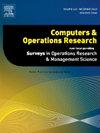多需求点可容设施选址问题的有效聚合启发式算法
IF 4.1
2区 工程技术
Q2 COMPUTER SCIENCE, INTERDISCIPLINARY APPLICATIONS
引用次数: 0
摘要
在区位分析中,需求聚集效应一直是许多研究的主题。这部分文献主要关注p中值和p中心问题。在有关聚集的文献中,明确讨论可容设施选址问题的论文相对较少。我们的工作考察了在CFLP的背景下聚合的有益使用。我们将重点放在需求点明显多于潜在设施位置的问题上,因为这是聚合在降低复杂性方面最适用的地方。我们研究了以固定分辨率获得聚合的方法,这对于给定的问题实例可能会执行得很好。这些聚合技术将形成一个更广泛的算法框架的核心,这有助于有关cflp启发式的文献。我们的核心聚合方法是基于在Rm中应用k-means聚类,其中m是潜在设施的数量。我们应用聚类的空间是通过对原CFLP问题对应的归一化距离矩阵进行变换来构造的。应用转换的目的是在相关的地方放大距离的差异,并压缩不相关的距离差异。我们基于一个真实的逆向物流问题,在更大的实例上评估我们的启发式方法。结果令人鼓舞,表明我们的方法能够优于直观的基准聚合方法。我们发现选择正确的超参数并从良好的初始化开始有助于我们的方法更好地执行。本文章由计算机程序翻译,如有差异,请以英文原文为准。
An effective aggregation heuristic for Capacitated Facility Location Problems with many demand points
In location analysis, the effects of demand aggregation have been the subject of many studies. This body of literature is mainly focused on -median and -center problems. Relatively few papers in the literature on aggregation explicitly concern the Capacitated Facility Location Problem (CFLP). Our work examines the beneficial use of aggregation in the context of the CFLP. We focus on problems where there are significantly more demand points than potential facility locations, since this is where aggregation is most applicable in reducing complexity. We examine ways to obtain an aggregation at a fixed resolution, that is likely to perform well for a given instance of the problem. These aggregation techniques will form the core of a broader algorithmic framework, which contributes to the literature concerning heuristics for CFLPs. Our core aggregation method is based on applying -means clustering in , where is the number of potential facilities. The space in which we apply the clustering is constructed by applying a transformation to the normalized distance matrix corresponding to the original CFLP problem. The aim of applying the transformation is to magnify differences in distance where relevant, and to compress irrelevant differences in distance. We evaluate our heuristic method on larger instances based on a real-world problem in reverse logistics. The results are encouraging and indicate that our method is capable of outperforming an intuitive benchmark aggregation method. We find that choosing the right hyperparameters and starting with a good initialization help our method perform better.
求助全文
通过发布文献求助,成功后即可免费获取论文全文。
去求助
来源期刊

Computers & Operations Research
工程技术-工程:工业
CiteScore
8.60
自引率
8.70%
发文量
292
审稿时长
8.5 months
期刊介绍:
Operations research and computers meet in a large number of scientific fields, many of which are of vital current concern to our troubled society. These include, among others, ecology, transportation, safety, reliability, urban planning, economics, inventory control, investment strategy and logistics (including reverse logistics). Computers & Operations Research provides an international forum for the application of computers and operations research techniques to problems in these and related fields.
 求助内容:
求助内容: 应助结果提醒方式:
应助结果提醒方式:


